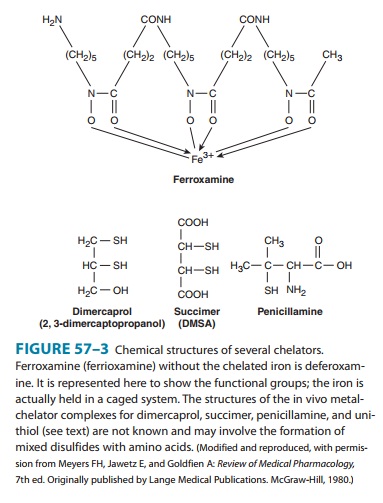Chapter: Basic & Clinical Pharmacology : Heavy Metal Intoxication & Chelators
Dimercaprol (2,3-Dimercaptopropanol, BAL)
DIMERCAPROL (2,3-DIMERCAPTOPROPANOL,
BAL)
Dimercaprol (Figure
57–3), an oily, colorless liquid with a strong mercaptan-like odor, was
developed in Great Britain during

It thus became known as British anti-Lewisite, or BAL.
Because aqueous solutions of di-mercaprol are unstable and oxidize readily, it
is dispensed in 10% solution in peanut oil and must be administered by
intra-muscular injection, which is often painful.
In
animal models, dimercaprol prevents and reverses arsenic-induced inhibition of
sulfhydryl-containing enzymes and, if given soon after exposure, may protect
against the lethal effects of inor-ganic and organic arsenicals. Human data
indicate that it can increase the rate of excretion of arsenic and lead and may
offer therapeutic benefit in the treatment of acute intoxication by arse-nic,
lead, and mercury.
Indications & Toxicity
Dimercaprol
is FDA-approved as single-agent treatment of acute poisoning by arsenic and
inorganic mercury and for the treatment of severe lead poisoning when used in
conjunction with edetate calcium disodium (EDTA; ). Although studies of its
metabolism in humans are limited, intramuscularly administered dimercaprol
appears to be readily absorbed, metabolized, and excreted by the kidney within
4–8 hours. Animal models indicate that it may also undergo biliary excretion,
but the role of this excretory route in humans and other details of its
biotransforma-tion are uncertain.
When used in
therapeutic doses, dimercaprol is associated with a high incidence of adverse
effects, including hypertension, tachy-cardia, nausea, vomiting, lacrimation,
salivation, fever (particu-larly in children), and pain at the injection site.
Its use has also been associated with thrombocytopenia and increased
prothrom-bin time—factors that may limit intramuscular injection because of the
risk of hematoma formation at the injection site. Despite its protective
effects in acutely intoxicated animals, dimercaprol may redistribute arsenic
and mercury to the central nervous system, and it is not advocated for
treatment of chronic poisoning. Water-soluble analogs of dimercaprol—unithiol
and succimer—have higher therapeutic indices and have replaced dimercaprol in
many settings.
Related Topics